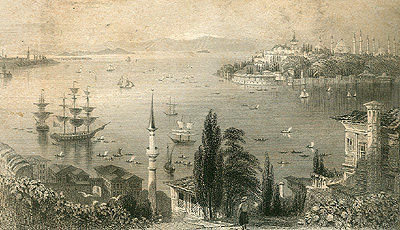 View from Seraglio Point, late 19th century magazine illustration References: "Home Life in Turkey" by Lucy M Garnett, New York, 1909 The Ottoman Lady: A Social History from 1718 to 1918, Fanny Davis, Greenwood Press They both describe a sequence of marriage social events extending over a whole week, following the negotiations of an arranged marriage. The bride was often very young, as marriage brokers, koulavous, watched the the public baths for girls who were at the onset of puberty having their first menstrual cycle, and were thus marriageable. Familes with sons contracted them to find suitable girls, and they returned from the baths to say, "the xxx family has a daughter like a full moon, perfect for your handsome son." Other arrangements were through families and friends. When the parents felt they had brokered a suitable match, the daughters often had very little choice in the matter, and refusing their parents decisions was difficult. The eldest daughter was offered first, younger daughters afterwards. According to the reports of Gannett, Davis and others who were not used to the system of arranged marriages and critical of it, state that girls who were not quickly snapped up during the ritual of cordiality, inspection, and brokering, suffered the lingering indignity of being called out for repeat performances until at age twenty-something were considered a hopeless case and were no longer bothered. Indigenous perspectives on arranged marriages were more complex and positive. The brokering often focused on emotional suitability, shared interests, economic advantage, and family connections: criterion similar to those used by modern dating services advertised on late night television to people who have limited acess to potential mates. 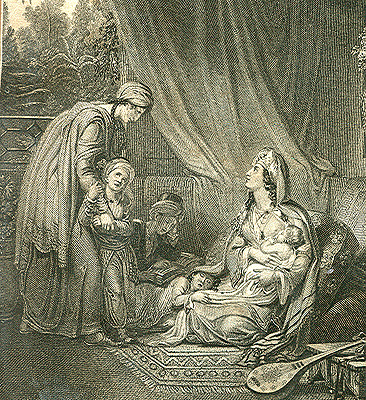 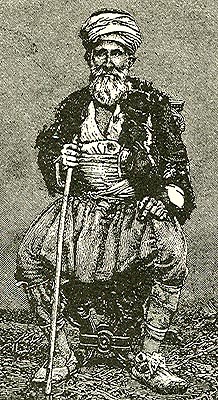 Women at home in Turkey, and Turkish father, late 19th century magazine illustration Marriages happened, for better or for worse. Virtually every male and female was legally mated, and the unmarried were officially regarded with pity, contempt and suspicion. Though fathers grumbled about expense, weddings were Ottoman women’s favorite events, and mothers liked to show off their daughters in the best style possible. They hired musicians, dancers, had feasts, and even threw coins into the street for beggars who gathered for a good marital extravaganza. The celebration went on for a week until the bride was taken to her new husband's house.. During the night of the henna, while guests celebrated, musicians played and dancers swirled outdoors, the bride went into her home’s reception room for her henna. The henna paste was brought in on a tray, with candles placed in the henna. The mother in law hennaed the bride’s right hand first, then her left hand, laying the henna on thick, and pressing a gold coin into it. Then, each guest pressed a coin into the henna. In poorer families, each guest put in the coin, then wrapped it over with gauze, both to cover the henna paste, and to mask any embarrassment they might feel over having less to offer than their neighbors. The bride’s hennaed hands were completely wrapped, henna, coins and all, her mother in law slid silk embroidered bags over her hands. Then, she hennaed the bride’s feet in the same way. When the henna was finished, the musicians and dancers came into the reception room to perform bawdy night of the henna dances for the bride and entertain the harem. The entertainers were all women, some with with penciled mustaches to pantomime male roles in the sexually instructive performance. The henna was not left in place overnight, because a red-orange stain was good luck. Dark brown or blackish stains were bad luck. Interpreting the Henna
Process
It
would be reasonable that Garnett and Davis, foreign guests at a wedding
celebration, would not have been invited to stand close to the bride
and mother in law during the henna. They are more likely to have
observed this from a distance They both describe putting the gold
coin into the thick henna paste, and the color of the stains the
work was completed. Other may be details missing from their
description of the process.
If henna was applied as
Rahime demonstrated for Arlene Brill,
applying henna over cord resist, Garnet and Davis might not have seen
that part of the process. However, if it may be assumed
that the wedding henna was comparable to henna depicted in
Turkish paintings of women, then we can proceed to
reconstruct the wedding henna. 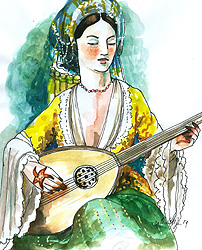 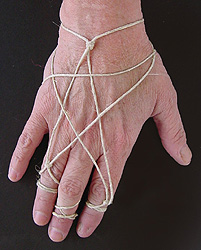 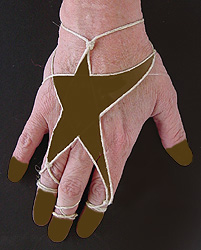 Detail from "Circassian
Slaves", 19th century lithograph by Allom
showing woman with hennaed hands, and proposed reconstruction of the thread cord resist technique. Larger image of "Circassian Slaves" HERE In paintings of Turkish women with henna, henna is depicted as being in broad patterns, bounded by straight lines, and some depictions show there was detail within the hennaed areas. If henna is applied thickly and wrapped as described by Garnett and Davis, any straight line or pattern will smear, unless those lines are created with a resist technique. The descriptions of bridal henna indicate that the henna was wrapped wet, because people were pressing coins into the henna. Coins would fall off dry henna. Bandage resist, such as is used in Mauritania, would be an effective resist for this, but surgical tape (adhesive bandage or sticking plaster) was not invented until 1922. Dough resist would be easily dislodged by the coins. The most easily available and effective resist for Turkish bridal henna would have been cord or thread, just as Rahime did. See: Turkish Village Henna: Cord Resist The painting above, a detail from "Circassian Slaves", a 19th century lithograph by Allom, shows henna from the same period as the verbal descriptions by Fanny Davis and Lucy Garnett. The henna is in a clearly defined pattern, consistent with henna laid down over a cord resist as shown below. This pattern can be made quickly by winding, looping, and knotting cord around a hand, or sewing a piece of lace around the hand This could be done quickly and firmly enough to would stay stable through the Kina Gecesi process of pressing in coins, wrapping and placing in the silk bags! Additional accounts of the Turkish Night of the Henna Eski Istanbul: Celal The women of Turkey and their folklore. Garnett 1890- 1891, v.2. Thirty years in the harem: Melek Hanim (Malik- Khanam) Chapman and Hall, 1872. The People of Turkey Mrs. Fanny Janet Blunt Turk Dugunleri: Kosay The Seed and the Soil: Gender and Cosmology in Turkish Village Society, Carol Delaney, University of California Press Return to the Index of Turkish Henna 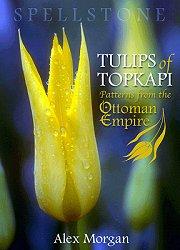
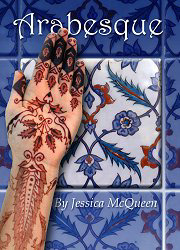 Alex Morgan's Tulips of Topkapi and Jessica McQueen's Arabesque have beautiful henna patterns adapted from Ottoman art! Available through TapDancing Lizard C |